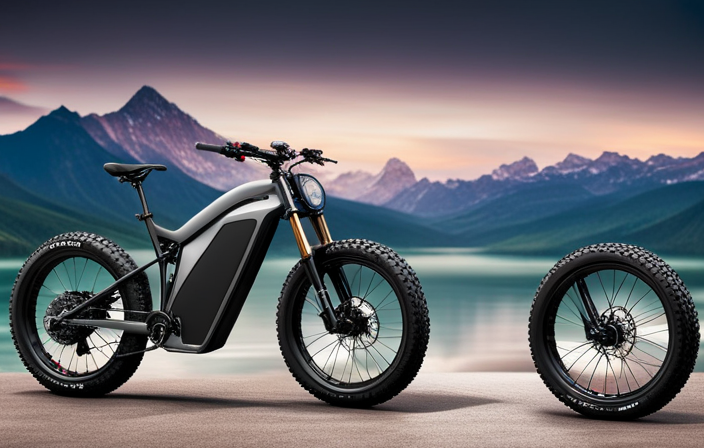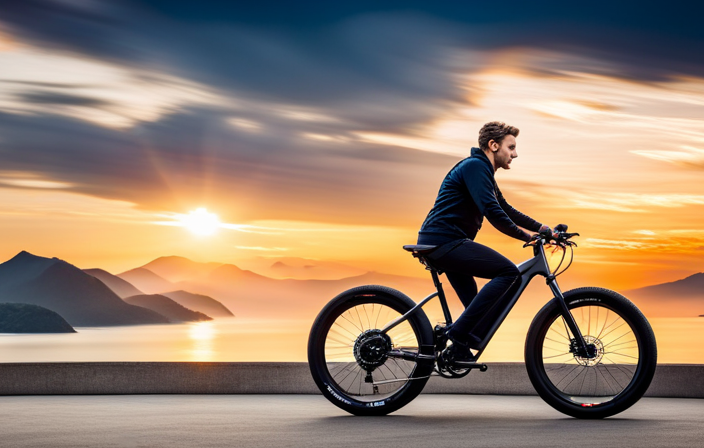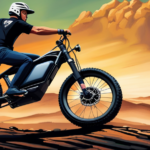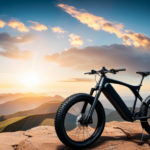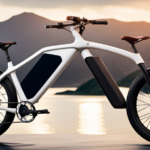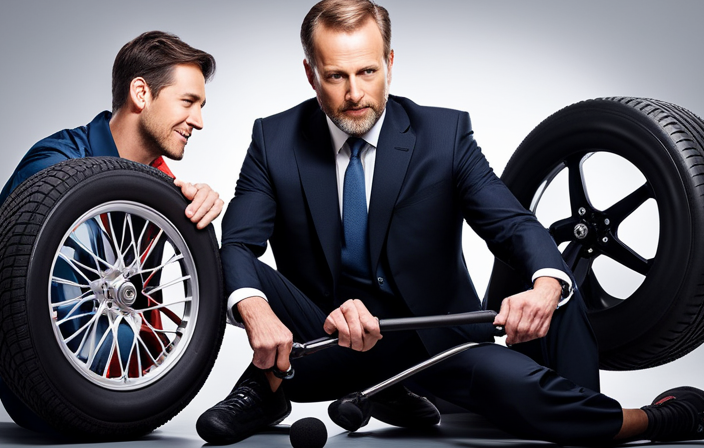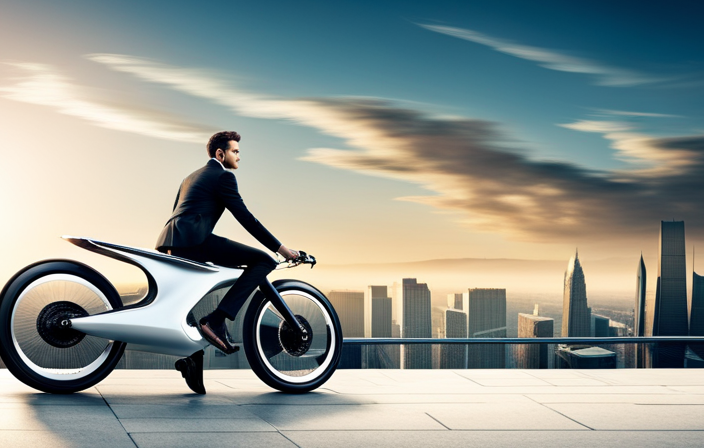As an avid cyclist, I’ve always been drawn to the challenge of conquering hills on my bike. But recently, I’ve been considering switching to an electric bike to make those uphill battles a little easier. That’s when I started wondering: just how powerful does an electric bike need to be for hills?
In this article, we’ll delve into the technical aspects of electric bike motors, explore the importance of power for hill climbing, and provide data-driven calculations to help you find the perfect electric bike for conquering those challenging inclines.
Get ready to power up and elevate your hill-climbing game!
Key Takeaways
- Motor efficiency is crucial for power output and energy usage optimization.
- Choosing the right power level for hill climbing depends on factors such as terrain and individual preferences.
- Balancing power and battery life is crucial for longer rides and efficient hill climbing.
- Considering motor power, battery capacity, and efficiency helps estimate range and conquer hills effectively.
Understanding Electric Bike Motors
Electric bike motors are essential for providing the necessary power to tackle hills. When it comes to calculating power output, there are a few key factors to consider.
First and foremost is motor efficiency. This refers to how well the motor converts electrical energy into mechanical energy. A more efficient motor will require less power input to achieve the same level of output. This is crucial for hill climbing, as it allows the motor to operate at its optimal level, minimizing energy waste.
Additionally, the power output of the motor is determined by its wattage. Higher wattage motors will generally have more power to tackle steeper hills.
Understanding the efficiency and power output of electric bike motors is vital in determining the level of power needed for successful hill climbing.
Importance of Power for Hill Climbing
To conquer steep inclines, you’ll want a bike that packs enough oomph to tackle challenging terrain. When it comes to hill climbing, power is essential. Here are some key factors to consider:
- Motor Power: A high-powered motor provides the necessary torque to overcome steep inclines.
- Battery Capacity: A larger battery capacity ensures a longer range and consistent power output.
- Power Efficiency: Calculating power efficiency helps optimize energy usage and extends battery life.
- Lightweight Frames: Lightweight frames offer advantages in terms of maneuverability and energy efficiency.
Calculating power efficiency involves analyzing the motor’s output and the energy consumed. Lightweight frames reduce the overall weight of the bike, making it easier to climb hills and improving power efficiency.
By considering these factors, you can choose an electric bike that is powerful enough to conquer hills with ease.
Moving on to the next section, let’s discuss the process of calculating power requirements without duplicating information.
Calculating Power Requirements
When calculating your power requirements, it’s important to consider factors such as motor output and energy consumption. Efficiency plays a crucial role in determining the power needed for hill climbing.
To calculate the power output estimation, multiply the motor output by the efficiency of the system. This will give you the power required to overcome the resistance and climb hills efficiently. The efficiency can be affected by various factors such as the weight of the rider, wind resistance, and the grade of the hill.
By accurately calculating the power requirements, you can ensure that your electric bike is capable of tackling hills with ease.
Now, let’s delve into the recommended power levels for various hill grades, ensuring optimal performance without compromising safety.
Recommended Power Levels for Various Hill Grades
If you want to ensure optimal performance without compromising safety, consider the recommended power levels for various hill grades. When it comes to motor power, it is crucial to have enough torque to conquer steep inclines.
Here are the recommended power levels for different hill grades:
-
Mild hills (4-6% grade): A motor power of 250-350 watts should be sufficient to handle these slopes.
-
Moderate hills (6-8% grade): To tackle these steeper inclines, a motor power of 350-500 watts is recommended.
-
Steep hills (8% grade and above): For these challenging terrains, a motor power of 500-750 watts is necessary to maintain a steady pace.
Having the appropriate motor power ensures that you can conquer hills with ease and without putting excessive strain on the bike. However, it is also essential to consider battery capacity and range considerations, which we will discuss in the next section.
Battery Capacity and Range Considerations
When considering the impact of power on battery life and range estimation for hill climbing, it is important to analyze the relationship between these factors.
The power required to climb a hill can significantly drain the battery, reducing its overall lifespan.
Additionally, accurately estimating the range for hill climbing is crucial for planning purposes, as it allows for efficient use of the battery’s capacity.
Impact of Power on Battery Life
To maximize your electric bike’s battery life, you’ll want to consider the impact of power on battery life. Power consumption plays a crucial role in determining how long your battery will last before needing a recharge. The more power your electric bike consumes, the faster your battery will drain. This means that if you’re frequently riding at high speeds or using the bike’s highest power settings, your battery will not last as long as it would if you were riding at lower speeds or using lower power settings.
It’s important to find a balance between power and battery life to ensure you can ride for longer distances without worrying about running out of battery.
Now, let’s discuss range estimation for hill climbing.
Range Estimation for Hill Climbing
In my previous discussion on the impact of power on battery life, I highlighted the importance of power efficiency in electric bikes.
Now, let’s delve into the topic of range estimation for hill climbing. When tackling steep inclines, the motor needs to deliver sufficient power to propel the bike uphill.
To estimate the range for hill climbing, several factors come into play. Firstly, the power output of the motor must be considered, as a higher power motor will provide better performance on hills. Additionally, the battery capacity and efficiency will affect the range. A larger capacity battery combined with power-efficient components will result in a longer range for hill climbing.
By accurately estimating the range for hill climbing, riders can plan their journeys accordingly and ensure they have sufficient power to conquer any uphill challenges.
Now, let’s move on to assessing motor power ratings to further understand the requirements for hill climbing.
Assessing Motor Power Ratings
Assessing motor power ratings helps determine how powerful an electric bike needs to be for hills. When it comes to calculating efficiency and choosing the right motor, it is crucial to consider the power output of the motor. To illustrate this point, let’s take a look at the following table:
| Motor Power Rating (Watts) | Hill Climbing Capability |
|---|---|
| 250 | Suitable for mild hills |
| 500 | Adequate for moderate hills |
| 750 | Powerful for steep hills |
As the table demonstrates, the higher the motor power rating, the better the hill climbing capability. However, it’s important to strike a balance between power and battery life. Choosing a motor with excessive power may drain the battery quickly. Therefore, it’s essential to assess the terrain and your own preferences to determine the ideal motor power rating for your electric bike.
Now, let’s delve into the next section and explore the additional features that enhance hill climbing performance.
Additional Features for Hill Climbing
When it comes to tackling steep hills, two key features that can greatly enhance the performance of an electric bike are gear systems and suspension systems.
Gear systems allow riders to adjust the bike’s gear ratio, providing them with the necessary torque to conquer challenging inclines.
Suspension systems, on the other hand, help absorb the impact of uneven terrain, ensuring a smoother and more comfortable ride.
Both of these features play a crucial role in optimizing hill climbing capabilities and improving overall riding experience.
Gear Systems
To conquer steep hills on your electric bike, you’ll want to make sure the gear system is optimized. The gear ratios on an electric bike play a crucial role in determining how efficiently it can climb hills.
Higher gear ratios provide more power and torque but require more effort to pedal, while lower gear ratios make pedaling easier but sacrifice power. It’s important to find the right balance for your specific needs.
Gear shifting also plays a significant role in conquering hills. Being able to shift gears smoothly and quickly allows you to adapt to changing terrain and maintain an optimal cadence. A well-functioning gear system can make a significant difference in your ability to climb hills with ease.
Now, let’s explore another essential feature for conquering hills: suspension systems.
Suspension Systems
Having a suspension system on your e-bike is crucial for a smooth and comfortable ride. The suspension system helps absorb the impact from bumps, potholes, and uneven surfaces, providing enhanced control and stability. It reduces the transmission of vibrations and impacts to the rider, resulting in a more enjoyable riding experience.
In addition to improving comfort, the suspension setup also affects the gear ratios on your e-bike. A well-tuned suspension system optimizes the gear ratios, allowing for better power transfer and improved climbing abilities. With a properly dialed-in suspension, riders can conquer hills with ease and efficiency.
Now, let’s explore electric bike models suitable for hill climbing.
Electric Bike Models Suitable for Hill Climbing
For tackling steep hills, you’ll want an electric bike model that offers strong motor power and torque. These bikes are equipped with powerful motors, typically ranging from 500 to 750 watts, and high torque capabilities, allowing for efficient uphill performance. When it comes to electric bike brands, some well-known options like Trek, Specialized, and Giant offer models specifically designed for hill climbing.
Regular maintenance is essential to ensure optimal performance. Keep the chain clean and lubricated, check the tire pressure, and inspect the brakes regularly. Additionally, it’s important to regularly charge the battery and store it in a cool, dry place when not in use.
Considering these factors will help you choose an electric bike that is well-suited for conquering hills with ease.
Factors to Consider When Choosing an Electric Bike for Hills
Consider the weight of the bike and how it affects your ability to climb hills easily. When choosing an electric bike for hill climbing, there are several factors to consider that will determine the power requirements.
-
Calculating Power Requirements: Take into account the steepness of the hills and your weight to determine the power needed to conquer them effortlessly.
-
Battery Capacity: A higher capacity battery will provide more power for uphill rides, ensuring that you don’t run out of juice halfway.
-
Range Considerations: Evaluate the range of the electric bike to ensure it can cover the distance you plan to travel on hilly terrains without needing frequent recharging.
-
Motor Power: Opt for a bike with a higher wattage motor, as it will deliver more power and help you overcome the challenges of climbing hills.
-
Torque: Look for a bike with high torque, as it will provide the necessary force to conquer steep inclines.
Considering these factors will help you choose an electric bike that is powerful enough for hill climbing.
Now, let’s delve into some safety tips for navigating hills with an electric bike.
Safety Tips for Hill Climbing with an Electric Bike
To navigate hills safely on your e-bike, remember to maintain a steady speed and anticipate any changes in terrain. Proper hill climbing technique is crucial for a smooth and efficient ascent.
Before tackling a hill, make sure your electric bike is in good condition by regularly checking the tire pressure, brakes, and chain. When climbing, it’s important to keep a consistent speed to avoid sudden shifts in power output. Shift to a lower gear to maintain a steady cadence and prevent strain on the motor. Look ahead and anticipate any obstacles or changes in gradient to adjust your speed accordingly.
By following these safety tips and maintaining your e-bike, you can confidently conquer hills with ease.
Transition into the subsequent section about the benefits of electric bikes for hill climbing. E-bikes have revolutionized the way we tackle hills, providing a powerful boost that makes climbing easier and more enjoyable.
Benefits of Electric Bikes for Hill Climbing
Transition: Now that we’ve covered safety tips for hill climbing with an electric bike, let’s explore the benefits of using electric bikes for tackling those challenging inclines. Electric bike technology has come a long way, offering riders a powerful and efficient solution for conquering hills with ease.
Advantages of Electric Bikes for Hill Climbing:
| Advantages | Explanation |
|---|---|
| Enhanced Power | Electric bikes are equipped with powerful motors that provide additional assistance when pedaling uphill, making it less strenuous. |
| Increased Speed | The motor’s power allows riders to maintain a consistent speed, enabling a smooth and efficient ascent on steep terrains. |
| Extended Range | Electric bikes have a longer range compared to traditional bicycles, ensuring riders can confidently tackle even the steepest hills. |
| Reduced Physical Fatigue | By providing electric assistance, riders experience less physical exertion, allowing them to enjoy longer rides without exhaustion. |
With these advantages, electric bikes are a game-changer for hill climbing. However, it’s important to consider the challenges and limitations that may arise when using electric bikes for hills.
Challenges and Limitations of Electric Bikes for Hills
If you’re planning to tackle hills with an electric bike, it’s important to be aware of the challenges and limitations you may encounter. While electric bikes are a great option for hill climbing, there are a few factors to consider.
Here are some key points to keep in mind:
-
Battery Life: When riding uphill, the motor will work harder, draining the battery faster. It’s crucial to understand the battery capacity and how long it will last during hill climbs.
-
Motor Efficiency: The power and efficiency of the motor play a significant role in tackling hills. A more powerful motor with higher efficiency will provide better assistance and make uphill riding easier.
-
Weight: Electric bikes tend to be heavier due to the motor and battery. This additional weight can make hill climbing more challenging, especially if the bike is not designed for off-road or steep terrain.
-
Gradient: The steepness of the hill will impact the performance of the electric bike. Steeper gradients will require more power and drain the battery quicker.
-
Skill and Technique: Riding uphill with an electric bike requires proper technique and skill. It’s essential to understand how to use the motor assistance effectively and manage your energy levels.
Understanding these challenges and limitations will help you make informed decisions and optimize your hill climbing experience with an electric bike.
Now, let’s dive into the inspiring testimonials and success stories from electric bike riders who have conquered challenging hills and achieved their goals!
Testimonials and Success Stories from Electric Bike Riders
When it comes to conquering hills, personal experiences play a crucial role in understanding the benefits of electric bikes.
As an avid cyclist, I have experienced firsthand the enhanced cycling enjoyment that electric bikes offer when tackling steep inclines.
The assistance provided by the electric motor allows for a smoother and more efficient ascent, resulting in a more enjoyable and satisfying ride.
Personal Experiences of Conquering Hills
I’ve found that having a powerful electric bike makes conquering hills much easier. As someone who has always enjoyed cycling but struggled with personal challenges when it came to climbing steep inclines, I was hesitant to tackle hilly terrains.
However, with the assistance of a high-powered electric bike, my fears were quickly overcome. The technical specifications of my electric bike played a crucial role in enhancing my cycling experience. The motor’s wattage, torque, and battery capacity were all optimized to provide maximum power and efficiency.
This allowed me to effortlessly ascend even the steepest hills with minimal effort. With each successful climb, my confidence grew, and I began to embrace the exhilaration of conquering challenging terrains.
This newfound enjoyment has transformed my cycling experience, making every ride a thrilling adventure.
Enhanced Cycling Enjoyment
After conquering those challenging hills, I couldn’t help but think about how to enhance my cycling enjoyment even further. That’s when I started exploring electric bike accessories and the best routes for hill climbing.
Equipping my electric bike with the right accessories not only improved its performance but also added a touch of personalization. Some of the must-have accessories I discovered were:
- High-capacity batteries for extended rides
- Upgraded motor systems for increased power
- Adjustable suspension forks for a smoother ride
These accessories not only made my bike more capable of conquering hills but also improved my overall riding experience. Pairing these accessories with the best routes for hill climbing allowed me to fully embrace the challenges and rewards of tackling steep inclines.
Now, let’s dive into some frequently asked questions about electric bikes and hill climbing.
Frequently Asked Questions about Electric Bikes and Hill Climbing
To tackle hills, you’ll want to know the frequently asked questions about electric bikes and hill climbing.
One common question is about battery capacity. The capacity of the battery determines how far you can travel on a single charge. A higher capacity battery will allow you to tackle longer, steeper hills without running out of power.
Another important factor is motor efficiency. A more efficient motor will convert a higher percentage of the battery’s energy into power to propel you up the hill. This means that even with a lower capacity battery, a bike with a highly efficient motor can still handle hills effectively.
Understanding these two key factors, battery capacity and motor efficiency, will help you choose the right electric bike for your hill climbing needs.
Now, let’s explore the conclusion: finding the perfect electric bike for hill climbing.
Conclusion: Finding the Perfect Electric Bike for Hill Climbing
Finding the perfect e-bike for hill climbing depends on understanding the key factors of battery capacity and motor efficiency.
When it comes to battery life, it’s crucial to consider the capacity of the battery pack. A higher capacity means more energy stored, allowing for longer rides and better performance on hills.
Additionally, motor efficiency plays a vital role in hill climbing. A more efficient motor will convert a larger percentage of the battery’s energy into propulsion, ensuring better power delivery and improved climbing ability.
To find the ideal e-bike, it’s essential to look for a high-capacity battery and a motor with excellent efficiency. By considering these factors, riders can enjoy longer rides and conquer even the steepest hills with ease.
Frequently Asked Questions
Are there any specific safety tips or precautions I should take when riding an electric bike on hills?
When riding an electric bike on hills, it is important to take safety precautions and use proper hill riding techniques. This ensures stability and control, preventing accidents and enhancing overall riding experience.
What are the benefits of using an electric bike for hill climbing compared to a regular bike?
When comparing an electric bike to a regular bike for hill climbing, the benefits are significant. The electric bike offers enhanced power and assistance, making it easier to conquer steep inclines with less effort and fatigue compared to a regular bike.
Are there any limitations or challenges to consider when using an electric bike for hill climbing?
When using an electric bike for hill climbing, there are several limitations and challenges to consider. These include battery life, weight, and motor power. These factors affect the bike’s performance and ability to conquer steep inclines efficiently.
Can I use an electric bike for hill climbing even if I don’t have much experience or physical fitness?
I can use an electric bike for hill climbing even without much experience or physical fitness. Electric bike stability and adjusting pedal assist can help compensate for lack of experience or physical fitness.
How do I determine the appropriate power level or motor rating for an electric bike that will be used for hill climbing?
To determine the appropriate power level and motor rating for an electric bike used for hill climbing, I analyze the incline gradient, rider weight, and desired speed. A formula combining these factors calculates the necessary power output.
Conclusion
As I conclude this journey through the world of electric bikes and hill climbing, I am reminded of the power and freedom that these machines can provide.
Like a soaring eagle, an electric bike with the right amount of power can conquer even the steepest of hills. It becomes a symbol of strength and determination, propelling us forward towards new heights.
With careful consideration of power requirements and battery capacity, we can find the perfect electric bike to conquer any hill.
So let us embrace this technological marvel, and let the hills be our playground.
